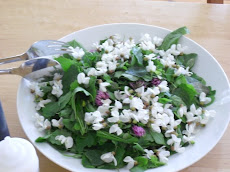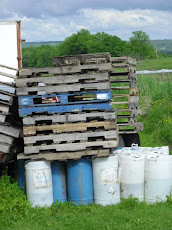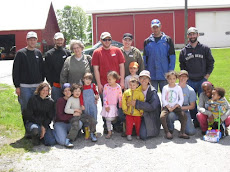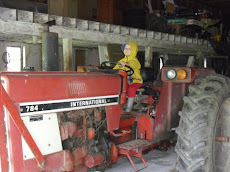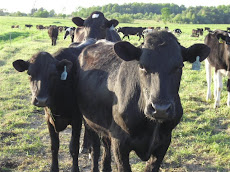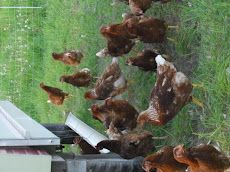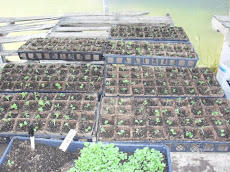In the movie Holes, the boys have to dig a 5 ft by 5 ft hole everyday. They’re told this exercise is “building character,” when in reality it’s to look for an impressive amount of wealth stored in a trunk, buried in the ground. Anyways, in the beginning of the summer, Eric, Ellyn and I did a lot of digging. Not 5 foot holes, thank God, but thousands of little holes for transplants, and we’d always joke that we were “building character.” As I write, on my last night here at Maplewood, I think of all that I’ve gained this summer, all the life long skills I acquired over the past three months surprise me beyond belief, and it’s been more of an experience than I could have ever imagined. I have to say though, aside from building your mind, building your appreciation for the earth, healthy soil, the farmers that work harder than probably any other occupation, building muscles; life on an organic farmer truly does in fact, build character.
After 5 hours on the road, 3 bathroom breaks, one car swap, our crew of Hannah, Susie, Ellyn, Eric and I finally made it down to Amherst Massachusetts for the NOFA (Northeastern Organic Farming Association) conference at U MASS. The three day event featured two phenomenal key note speakers, a series of many diverse workshops, a fair, farmers market, and even a night of contra dancing! Friday’s keynote speaker….can’t remember his name…. spoke all about the wonderful world of mushrooms and fungi and their growing role and importance in rebuilding nutrient rich soils and even helping cure illnesses. Last nights speaker, Will Allen, is a farmer from Milwaukee. His strong build and impressively tall height gives him a powerful presence, his dark skin color stands out at a Northeastern Organic farming convention, and his work inspired us all. In the heart of Milwaukee, he started, Growing Power, a working farm and educational outreach program, which seems to have blossomed into an empire since it began about 20 years ago. He grows pretty much anywhere he can, has a staff of 35, all nationalities and all ages, works with inner city kids, teaching them where their food comes from, has brought his work to Kenya, teaching them to build up their soil, produces all his own soil through compost and red worms, and so much more! Clearly Will inspired at least one of his audience members.
I attended workshops on starting a campus garden at your college, water bath canning, sheep raising, baking no knead bread, engaging inner city youth with community gardens, becoming more self reliant during economic times…. Some more interesting than others, but all good! The fair, which took place on the campus green, yesterday afternoon, had all sorts of country fun! Cow’s pooped on grids, kids raced to eat corn on the cob off dangling string, adults raced to shove down expensive, organic pies, People spit watermelon seeds, cattle dogs rounded up ducks, and people made butter! Clearly, a wild and crazy time was had by all. ;)
So…it’s my last night. After living with the Noel’s, sharing one bathroom with 6 other people, weeding for hours in the field with a blazing sun beating down, weeding in the field with rain drops beating down, selling at successful markets, selling at not so successful markets, collecting and washing dozens upon dozens of chicken eggs, trying to keep Eric from killing Stewy, laughing hysterically with Ellyn over absolutely nothing, answering many questions asked by Maddy and Calvin, jarring sauerkraut (which is the only food here I won’t eat!), watching cows shipped away to the butcher, then eating the heart of “Pretty” unknowingly in a stew….it’s been one hell of a summer!
I can’t even begin to articulate back all that I’ve learned and gained from this experience…. I hope that I’ve inspired some of you readers to look into the food system more, learn where you receive their own food from… and all that jazz. But maybe more importantly, perhaps inspire you to simply, start a garden of your own; even if it’s just some pole beans and peas (which I would suggest, because they’re real easy), is a great way to start. Can with your family in the fall. For all you Central New Yorkers like myself, canning our wonderful apples in October would be a great way to taste the fall during those long cold winters! Cook meals with your family, housemates, or friends from scratch, visit a farm and see how the whole process works. Food connects us. All of us eat. It’s as simple as that, and in my opinion, it’s the best way to change direction our environmentally destructive world is heading in. We all need to eat, so if they way we obtain our food is done in a sustainable way for the planet and our bodies, I like to believe we’ll see how everything else connects and relates to all life on earth, and fix that whole mess too. But don’t just join a CSA or buy organic blueberries because it’s trendy or you want to “go green”, do it to become a part of natural cycle of food, and understand its value and importance.
But I’ll get off my soap box, and wrap up this final blog! It’s strange, knowing this life is coming to an end tomorrow morning. I’ll miss smelling tomatoes as I walk down their rows, looking for ripe ones to pick. I’ll miss watching the mist rise off the pasture on early mornings when I feed the chickens, miss getting hugs goodnight from Maddy and Calvin every night while I’m typing this blog, miss not having my cell phone on me all the time, and not having to wait for someone to finish texting before I can talk to them. I’ll miss Stewy, and calfy, those crazy harvesting morning, crusin’ in Ellyn’s Legacy listening to her old blues tapes, eating beans and peas right after I pick them, because those couple serve better in my stomach than a CSA member’s. I’ll miss jumping in the pond after a sweaty afternoon of weeding, racing Ellyn to the camper at night, and sleeping in it, we’ve made it quite homey believe it or not! But, guess it’s time to get back to my “other life”, and plus, I really miss my dog ha ha. So that’s it. That’s my organic summer. Hope you’ve enjoyed following the experience as much as I’ve enjoyed living it and writing about it. :)
Don’t be afraid to get your hands dirty and see what you can grow! There’s a whole bunch of un-used land out there, just waiting to grow delicious life from it, so why not bust out those action hoes and old ripped jeans, and go to town with your green thumb? Because what’s the worst that could happen? Even if a bug eats your kale before you get a chance, or your lettuce goes to seed because you waited too long to harvest it, at least you’ll build some character, right? ;)
My Suggestions on what to grow your in your first garden:
1. Sugar Snap Peas! They’re so delicious right off the plant and you don’t need to weed, because weeds support the plant!
2. Rattlesnake Pole Beans. So scrumptious, again, right off the plant. You’ll have a cool looking tee-pee in your yard, with beans growing on them, all your neighbors will be jealous.
3. Squash. Winter or summer, winter just takes a lot longer. The leaves get big, so it’s usually less weeding.
4. Heads of lettuce. Who does like a fresh salad with a summer dinner?
5. Kale and Swiss chard! You can cut their leaves pretty early into the growing season, or wait until the get really big! Just cut leaves off the stem and more will keep growing back throughout the summer!
6. Beets, carrots and radishes. Because they’re colorful and fun to find when you dig them up!
P.S. I have some more pictures to post, but the chord that connects my camera to my laptop seems to have run off on me, so hopefully they'll show up soon!
Sunday, August 9, 2009
Thursday, August 6, 2009
Life on an organic farm is...for me, soon and strangely coming to an end
As my days living and working at Maplewood come to an end, I surprisingly spent the afternoon of my last full day at Maplewood, not at Maplewood. Ellyn and I traveled down the road in her trusty old Subaru Legacy, to Guy’s Dairy farm, for four hours of working with some lovely Holsteins. Guy and one of his hired hands, twelve year, Caleb, showed us the ropes, where to shovel old hay, where to shovel lots and lots of cow poop, how to lead the cows into the barn from the pasture, clean their tits with diluted iodine, hook up the milking machines to the pipes running up through the barn and hook the suckers on to their tits. Extremely educational to say the least, we jumped right in and learned the only way we’ve been learning all summer, hands on.
The odor of the shit, as they all kept referring to it as, fills most of the barn, as expected. Pre-milking chores include racking the poop from under the cows in their stalls, onto the indented track behind where they stand, which pushes all the cow waste, for a better term, into a 12 foot deep storing well, that Guy has admitted to climbing down to save a kitten! Farm cats and kittens walk everywhere around the barn, weaving in and out through the cows, and Guy’s trusty black lab, Scout, trailed right behind us almost everywhere we went. The farm had a strong family feeling to it, as his son and daughter help with chores, and neighbors know to come in during the milking hour to catch up with Guy.
It’s defiantly a different type of farming, from the vegetable tending we’ve become accustomed to these past three months, but enjoyable known the less! Guy, who’s so connected to his cows, recognizes their needs, would tell me their names, if they had them, and which ones where stubborn, which ones would need a push out, or which one would be easiest on my first try at milking. We reeked of the barn and cows at dinner, and heard it from the Noel’s as we sat down to eat our stew, which was made with cow heart! :0 Talk about being resourceful!
In the morning, Ellyn and I planted some more beets, to fill in where other beets failed to grow, started catching up on some much needed weeding in the onion row, and prepared for the CSA farm pick up. One of my favorites, green peppers, finally have started to grow large enough that we can begin to harvest them! They smell as lovely as they look, but a large portion of them will be left on the plant until they turn red. I’m loving beans more than I ever would have imagined! If I could suggest a list of vegetables to grow in a home garden, beans would be top of the list. Provider bush beans, Rattlesnake pole beans (which produce an amazing tie-dyed like coloring) and Gold Rush bush beans all have grown amazingly and taste delicious. Pole beans have the advantage of not having to weed either. :)
Tomorrow morning, Eric the intern, Hannah, Ellyn, Susie and I all hit the road for our NOFA conference in Massachusetts for a weekend of expanding our organic farming minds. :) Then I hit the road on Monday, leaving the farm, and returning to my other life; meaning, among other things, no more blog. :( I’ll have one last post after the conference, but would love to ask something of, hopefully, all you readers out there! I’ve been hearing from different people, that so and so has been reading the blog, and would love for some feed back from you! I don’t care if I know you, if we’re best friends or just acquaintances, if you know me through Hannah, even if I have no idea who you are! I’d love to hear if you’ve enjoyed following this experience, if you’ve learned anything, used any of the information I’ve given, changed the way you’ve looked at your food, maybe even if I convinced you to buy more organic food. :) I’d really appreciate it, and the more elaborate you are the better! Even include what I could have done differently, or what else you would have liked too see. You can email me at hmgibbon@syr.edu with your “evaluation” so to speak. Thanks in advance, and again, I would really, really like to hear what you have to say about it! Don’t be shy now!
The odor of the shit, as they all kept referring to it as, fills most of the barn, as expected. Pre-milking chores include racking the poop from under the cows in their stalls, onto the indented track behind where they stand, which pushes all the cow waste, for a better term, into a 12 foot deep storing well, that Guy has admitted to climbing down to save a kitten! Farm cats and kittens walk everywhere around the barn, weaving in and out through the cows, and Guy’s trusty black lab, Scout, trailed right behind us almost everywhere we went. The farm had a strong family feeling to it, as his son and daughter help with chores, and neighbors know to come in during the milking hour to catch up with Guy.
It’s defiantly a different type of farming, from the vegetable tending we’ve become accustomed to these past three months, but enjoyable known the less! Guy, who’s so connected to his cows, recognizes their needs, would tell me their names, if they had them, and which ones where stubborn, which ones would need a push out, or which one would be easiest on my first try at milking. We reeked of the barn and cows at dinner, and heard it from the Noel’s as we sat down to eat our stew, which was made with cow heart! :0 Talk about being resourceful!
In the morning, Ellyn and I planted some more beets, to fill in where other beets failed to grow, started catching up on some much needed weeding in the onion row, and prepared for the CSA farm pick up. One of my favorites, green peppers, finally have started to grow large enough that we can begin to harvest them! They smell as lovely as they look, but a large portion of them will be left on the plant until they turn red. I’m loving beans more than I ever would have imagined! If I could suggest a list of vegetables to grow in a home garden, beans would be top of the list. Provider bush beans, Rattlesnake pole beans (which produce an amazing tie-dyed like coloring) and Gold Rush bush beans all have grown amazingly and taste delicious. Pole beans have the advantage of not having to weed either. :)
Tomorrow morning, Eric the intern, Hannah, Ellyn, Susie and I all hit the road for our NOFA conference in Massachusetts for a weekend of expanding our organic farming minds. :) Then I hit the road on Monday, leaving the farm, and returning to my other life; meaning, among other things, no more blog. :( I’ll have one last post after the conference, but would love to ask something of, hopefully, all you readers out there! I’ve been hearing from different people, that so and so has been reading the blog, and would love for some feed back from you! I don’t care if I know you, if we’re best friends or just acquaintances, if you know me through Hannah, even if I have no idea who you are! I’d love to hear if you’ve enjoyed following this experience, if you’ve learned anything, used any of the information I’ve given, changed the way you’ve looked at your food, maybe even if I convinced you to buy more organic food. :) I’d really appreciate it, and the more elaborate you are the better! Even include what I could have done differently, or what else you would have liked too see. You can email me at hmgibbon@syr.edu with your “evaluation” so to speak. Thanks in advance, and again, I would really, really like to hear what you have to say about it! Don’t be shy now!
Tuesday, August 4, 2009
Life on an organic farm is...so educational!
Yesterday evening, after we finished up picking beans, which are coming in leaps and bounds, and very tempting to just keep muchin’ on while walking hunched over down the row... :) Ellyn, Eric and I headed down the road to an organic dairy farm. Since we don’t get to experience that aspect of farming, we thought we’d visit Highgate’s very own, and winner of Sustainable Farmer of the Year for the state of Vermont, Guy Choiniere. An enthusiast about his farming to say the least, Guy greeted us with a smile, as he whipped off his hands on his already dirty clothes, and cleaned off his old school, Ben Folds glasses on his shirt. We followed him into the barn, where he and his father were just about to finish up with the evening milking. He said to take no offense, but our beef cows at Maplewood have nothing on his dairy cows. They work harder he said, dairy cows are like Olympic athletes, and need to be treated like them. Taking a mile a minute, about everything from his cows to the soil, he walked with us all around the farm and property. “Sorry, us organic farmers have a lot to say!” He said, as he could probably see it in our faces that our minds were trying to absorb each and every fact he told us.
Guy's farm houses 65 dairy cows, which each eat 70 to 80 pounds of feed a day, and drink at least 50 gallons of water a day, if I’m remembering correctly. The more grass they eat the better; it’s better for the cow, and saves him on grain, which used to cost him $100,000 a year before he switched to organic. “It all starts with the soil.” Guy relayed to us many times. All life comes from the soil, so it’s crucial that it holds the right balance of nutrients and minerals, “Calcium is the King!” he’d say. If you have good soil, all else will come into its place. Visiting Guy’s farm just reiterated to me that the way we live, with the food we eat, how we treat our land, is really just a continuing cycle; where every action has a consequence, and everything relates to everything else. Pumping your land with fertilizer isn’t allowing all the cycles and systems that occur underground to properly carry out, which is going to show in what grows from that soil, and the food it eventually creates.
An Olympic trainer, a nutritionist, day-care specialist, (all relating to his cows of course), Guy does it all and knows it all. He can tell how well a cow’s body is digesting her food by looking at her manure, and told us this as a big sloppy cow pie exited the back end of a lovely lady, splashing on the barn floor and partially landing on my left leg and hand. It’s been a learning experience for him, as he learned to combined farming practices of his grandfather, whose cows lived a long life, but didn’t produce a lot of milk, and his father, who could produce a lot of milk, but couldn’t keep a cow long. From what I could tell, he’s now got the best of both worlds. The average dairy cow in America milks for 3 and a half years, Guy’s cows milking averages 8 years.
We walked the farm road through the pastures that his cows travel, in through an overflowing creek, under a slippery manure soaked tunnel, and I was super smart and wore my flip flops…. We even got the pleasure of going into the covered barn yard, were his girls go in the winter, in which we stood on 6 feet of manure! The manure in there is brought out to the fields in October; he said he’s noticed a huge difference in the yield of his grass when he switched from conventional. He taught us so much, all extremely interesting, that I wish I could relay it all back! It’s so critical for farmers to understand the science behind their fields, and under their soil, and the needs of their animals. The greater knowledge shows through with results of more efficient production and healthier animals. I asked him when his last day off was, and he just laughed. “Ya never get a day off! You’ve got to love it, and I do!”
I meant to go back this evening to take pictures of the dairy farmer in action, but after putting up more hay, taking a “family” outing to Lake Carmi for a swim, then creemees :)... I didn’t get around to it! But look for pictures soon, as I’ll return to Choiniere’s Dairy, and this time know to wear my boots. :)
Check out an NYT article about Guy and his work with eliminating the methane release from his cows!
http://www.nytimes.com/2009/06/05/us/05cows.html?pagewanted=1&_r=1
Guy's farm houses 65 dairy cows, which each eat 70 to 80 pounds of feed a day, and drink at least 50 gallons of water a day, if I’m remembering correctly. The more grass they eat the better; it’s better for the cow, and saves him on grain, which used to cost him $100,000 a year before he switched to organic. “It all starts with the soil.” Guy relayed to us many times. All life comes from the soil, so it’s crucial that it holds the right balance of nutrients and minerals, “Calcium is the King!” he’d say. If you have good soil, all else will come into its place. Visiting Guy’s farm just reiterated to me that the way we live, with the food we eat, how we treat our land, is really just a continuing cycle; where every action has a consequence, and everything relates to everything else. Pumping your land with fertilizer isn’t allowing all the cycles and systems that occur underground to properly carry out, which is going to show in what grows from that soil, and the food it eventually creates.
An Olympic trainer, a nutritionist, day-care specialist, (all relating to his cows of course), Guy does it all and knows it all. He can tell how well a cow’s body is digesting her food by looking at her manure, and told us this as a big sloppy cow pie exited the back end of a lovely lady, splashing on the barn floor and partially landing on my left leg and hand. It’s been a learning experience for him, as he learned to combined farming practices of his grandfather, whose cows lived a long life, but didn’t produce a lot of milk, and his father, who could produce a lot of milk, but couldn’t keep a cow long. From what I could tell, he’s now got the best of both worlds. The average dairy cow in America milks for 3 and a half years, Guy’s cows milking averages 8 years.
We walked the farm road through the pastures that his cows travel, in through an overflowing creek, under a slippery manure soaked tunnel, and I was super smart and wore my flip flops…. We even got the pleasure of going into the covered barn yard, were his girls go in the winter, in which we stood on 6 feet of manure! The manure in there is brought out to the fields in October; he said he’s noticed a huge difference in the yield of his grass when he switched from conventional. He taught us so much, all extremely interesting, that I wish I could relay it all back! It’s so critical for farmers to understand the science behind their fields, and under their soil, and the needs of their animals. The greater knowledge shows through with results of more efficient production and healthier animals. I asked him when his last day off was, and he just laughed. “Ya never get a day off! You’ve got to love it, and I do!”
I meant to go back this evening to take pictures of the dairy farmer in action, but after putting up more hay, taking a “family” outing to Lake Carmi for a swim, then creemees :)... I didn’t get around to it! But look for pictures soon, as I’ll return to Choiniere’s Dairy, and this time know to wear my boots. :)
Check out an NYT article about Guy and his work with eliminating the methane release from his cows!
http://www.nytimes.com/2009/06/05/us/05cows.html?pagewanted=1&_r=1
Subscribe to:
Posts (Atom)



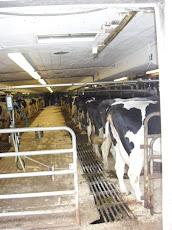




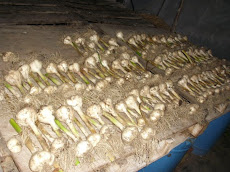



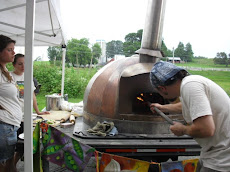

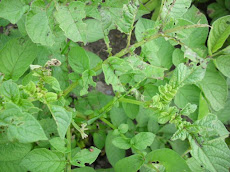



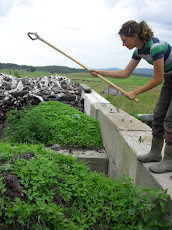



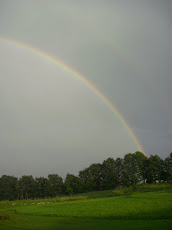
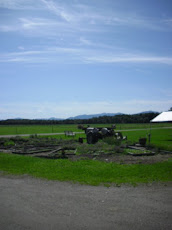
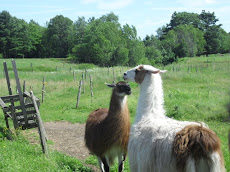

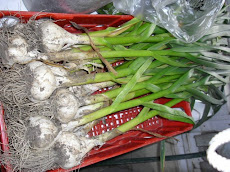




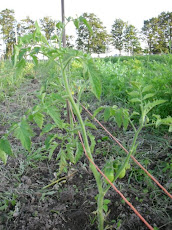






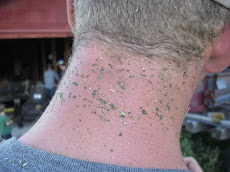

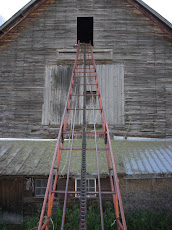



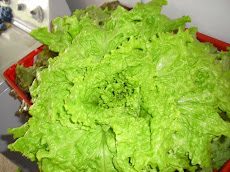

.jpg)

